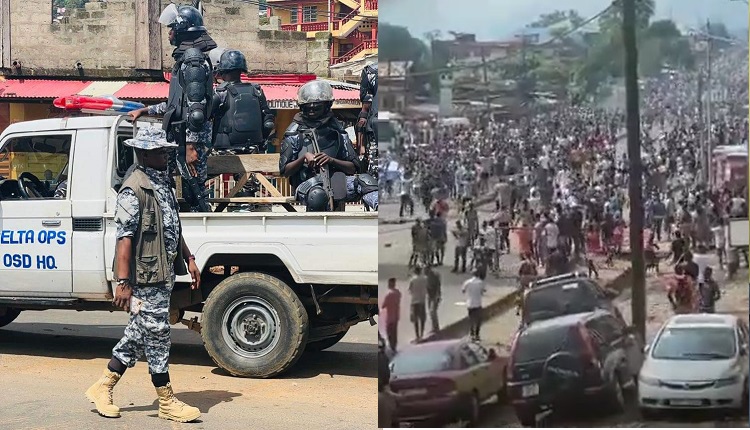Community disturbances resulting from the use of excessive or deadly force continue to plague many communities. Law enforcement is an important societal function and its effectivenes is hampered when tensions exist between the police force and the public it serves.
Over and over, one thing we have learned is that good policing practices are essential to developing community support. Other elements include trust and confidence in the administration of justice. With this foundation, the prospect of successfully dealing with the potential for violent disturbances in the community is greatly enhanced. Moreover, a healthy relationship between the police and the community diminishes the prospect of the police using excessive force at all.
Incidents of police use of excessive and lethal force can be prevented, and the turmoil in the communities in the aftermath of such an incident can be reduced; civil unrest and disorder is not a necessary consequence of such a terrible tragedy.
Even after pursuing formal avenues like criminal prosecutions and civil litigation, we are still left with a need to address the underlying, unresolved concerns. Few police officers or minority members, given the option, would choose the state of affairs depicted in this composite incident to characterize their relationship. Even though deaths are not always involved in incidents of police officer use of excessive force, unfortunate incidents similar to this occur all too frequently. These incidents raise the central question addressed in this handbook: is it possible for police and minorities to find means of dealing with their differences short of legal or legislative actions?
The answer clearly is yes. The power of conciliation to produce a mutually desirable outcome in even the most difficult circumstances is well established. Conciliation brings opposing parties together to hear each other’s point of view and to find common ground. Because the parties may never have engaged in such a dialogue, e act of coming together may itsell help to ease tensions and reduce misunderstandings. When conciliation produces a lasting solution to troubled police-minority relations, everyone benefits aggrieved minority residents, the police, and the entire community. If conciliation efforts fall short, on the other hand, neither the police department nor minority community will have lost their options to pursue other courses of action available to them.
A conciliation effort requires that the police department and minority community look at their overall relationship. While a single issue, such as the department’s firearms policy, may be the immediate cause of such a dialogue, no single issue exists in isolation from other departmental policies and practices. Minority leaders and the police chief, preferably with the support of city officials, have to approach such or with the willingness to pursue actions that offer the prospect of creating constructive change in the entire police-minority relationship. In the following pages actions are proposed for police departments and community organizations to break down the barriers to good relations and to deal constructively with the issues surrounding disputes of police officer use of excessive force.
Controversy over firearms policy and use of excessive force is inseparately tied to the overall quality of relations between the community population and the police. Where police and all groups in the community develop good relations, friction generally is minimized. The perception of the police as concerned, professional, and fair leads to greater respect throughout all segments of the community. Likewise, police officers’ confidence that they can count on the support of all the community population in the performance of their duties gives them a greater sense of confidence in doing their job. An effective police-minority relationship can contribute to the reduction in incidents of excessive police force. However, in the event, an incident of excessive force does occur, the public is more likely to respond with an open mind due to the positive relationships and trust built up with the police through daily experience.
Community organizations might consider two other possibilities as an aid to improving relations with police. Explore the establishment of communications links to professional police associations as well as with the police union, and institute an annual award for the police officer believed to have contributed most significantly to positive police-community relations. While it might seem at first glance that the two programs have few common interests, in many situations there are mutually beneficial grounds on which to cooperate.
American society has always been characterized by change in its racial and ethmic composition. At the start of the Twentieth Century, the US. population was largely made up of persons with a British Isles heritage and with the African American population concentrated in the southern part of the country. The immigration patterns at the start of the century brought an influx of southern and castern Europeans. The industrial production precipitated by two world wars contributed to the migration of African Americans from the south to northern cities. The change in immigration laws in the 1970’s, along with refugees from southeast Asia, broadened the representation of Asian Americans that had immigrated from China, Japan, and the Philippines L during the preceding century. Job opportunities brought many immigrants from Mexico. Political turmoil in Central America also contributed to the growth of the JHispanic population in the country. Today, the United States is more diverse in religion, race, nationality and cultures than at any other point in its short history.
Racial and ethnic diversity is one of America’s strengths, but this diversity also represents a challenge to policing. A police officer’s lack of familiarity with the customs and mores of various ethnic and racial groups can lead to misunderstandings and conflict. Cultural parochialism wherein police officers are only familiar with their own heritage does not provide a solid foundation for effective policing. Cultural colonialism wherein the values of the dominant ethnic group in the department become those of the department is a prescription for friction between the police and the communities that they serve.
Police departments have to work hard to become familiar with the various ethnic and racial groups that they serve, to understand their languages, customs and traditions, and to establish mechanisms for communicating with them. A component of such communication ought to be in the department’s articulation of its values in interacting with the community.
One of the tenets of policing in the current era is the requirement for a cohesive community working with a responsive police department. Violent confrontations between police and their service population does not support a cohesive community or a responsive police department. Unfortunately, unjustified violence between police and minority members is not something from an era of policing that is behind us, as evidenced by recent, well publicized cases across the county.
Some agencies never lost a community orientation in their policing. Some agencies may have recently regained their community orientation that was previously sidetracked due to the technological developments of the squad car and the two way radio. Other agencies may have never had a community orientation. Regardless of departmental history, community policing is a philosophy in which the police engage residents to solve problems in their communities. Community policing is a broad concept that can take on many different forms among the host of local police agencies operating in the United States. Nevertheless, there are common elements that characterize a community policing approach. Community policing emphasizes the view that the community is a partner in the performance of the police mission. Community policing does not view the minority neighborhood as a territory to be occupied. The community has a role in keeping neighborhoods safe and free of the fear of crime. Departments operating under a community policing philosophy endeavor to understand the concerns of the community. This approach requires that line officers move from such narrow functions as writing up incident reports to developing interpersonal skills that enable them to engage people of all backgrounds, listen to their concerns and to devise collaborative responses to those concerns.
Eliciting community concerns can be accomplished through a variety of means, including: one-on-one contacts between the police officer and the public; the attendance at, and participation in, community meetings; and surveying residents about their concerns and priorities through the mail or on the phone. Collective problem solving is the key to effective community policing.
When police departments address issues that concern the community, better relations can develop between them. Being a good community police officer can also mean being a more effective crime fighter. Community policing makes residents partners for the police not only in their crime control efforts, but also in making improvements in the community’s quality of life.
Community policing creates a positive atmosphere for police community relations and provides the foundation for effective partnerships, even for assertive crime control initiatives. Assertive, however, does not have to mean abusive. A department can set objectives (reduce complaints, police shootings, and injuries to civilians) and then set out to shift the culture to accomplish these objectives by developing policies and procedures, training it officers and monitoring them for compliance.
The primary focus of this handbook is to assist police agencies and communities reduce violent confrontations between police officers and the public. The successful accomplishment of this objective should produce two major benefits. First, this would enhance the safety of both police officers and the residents whom they serve. Second, this objective will foster an atmosphere of cooperation and mutual respect between the police and the community. To initiate this process, a police department must determine whether its organizational culture is conducive to reducing violent confrontations between the police and the public.
A mission statement describes the fundamental role of an organization in support of its vision; i.e., why it exists; its constancy of purpose, with a single overriding goal statement.
The role of government is to provide a wide variety of community services, including health, education, recreation, library and public safety services. The police department is one of the most important governmental services offered to the community. The mission of a police department should include such activities as: crime prevention; victim assistance; providing for the public’s safety; protection of property; and the enforcement of the law.


 Post a comment
Post a comment 









